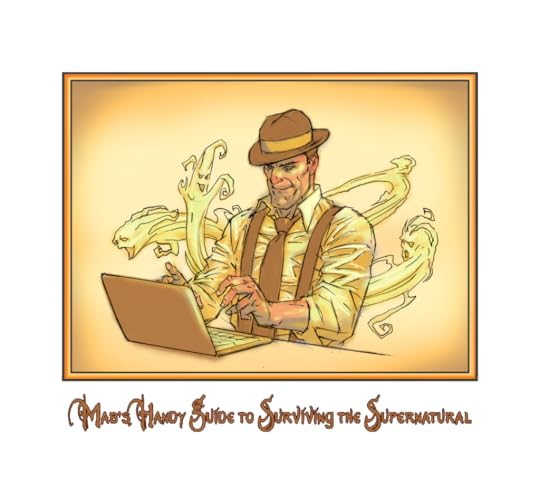L. Jagi Lamplighter's Blog, page 41
February 3, 2014
Caption This Winner
Boy, we had some good ones this week! I'm going to reprint a few below, but the winner, the most wonderful of the wonderful was:
"No dreaming of impossible dreams within the city limits"
Some other good ones:
Next thing they'll have are (golden) helmet laws
Four-armed giant habitat. No tilting.
Helping to protect the endangered giant
What? It works — he hasn't shown up yet!
and
The giants got wise after a while.
January 29, 2014
Wright’s Writing Corner: Open Active!
Next in our series of posts expanding on my Writing Tips list, we have:
Open active: Start scene with changes underway and then explain how you got there…unless change are significant.
First: what do I mean by openings? In this case, I mean the beginnings to new scenes and chapters. Much of this could also be applied to first lines, but first lines have additional issues weighing upon them. So, for the most part, I am talking about internal openings—how to start after a scene change.
Second: what do I mean by opening actively. An active opening is when you start your scene in the middle of the action, where something interesting is already going on, instead of with a bridging scene that connects the previous scene to the next scene.
Active openings are also called In Medias Res, which, for the Latin Illiterate (like myself) is a phrase meaning something like “in the middle of the affair.”
Just to make sure we are all on the same page, here are two examples of openings—one active, one not:
1) The next day, we rose early and washed the car. After that, we headed down Route 66.
2) “He’s gaining on us! Step on it!” Carly yelled. She hung half out the passenger window, so that when I swerved around the rolling oil drum, she nearly fell out of the car.
Why is an active beginning interesting? Two reasons: the active opening sentence is often more interesting in and of itself. (See above.) Second, it raises questions: what is going on? Why is this happening? Who is chasing them? The more questions the reader has—assuming that they have faith that the author will provide answers—the more eager the reader is to read on.
There is another benefit as well. Starting in the middle often makes the whole scene more interesting. It tends to jump right to the exciting part, skipping the lead up. This helps keep the scene on track and moving quickly.
The key to the active opening is two things: picking an arresting scene and filling in the gap.
Picking an arresting scene: Picking a scene that will draw the reader’s interest requires that you think out the events you want to have happen and pick a moment from it that is early enough that the main action has not happened yet, and yet far enough along that the action has already begun.
The action does not need to have fully begun. In the above example, instead of starting with the chase, I could have started with:
“There’s a red Honda following us.” Carly leaned out the window, her hand shading her eyes. “Does that mean anything to you?”
This beginning is also active—far more active than the first one. But it requires less explanation for the reader to grasp how the main characters reached this spot. Which leads us to our second point.
Filling in the gaps: Jumping in the middle of the scene means you have to take at least a moment to go back and explain what happen between the previous scene and the current action—how the characters got to the exciting predicament they are in now. Usually, this is done by a mini-flashback in the first few paragraphs of the new scene. You do not want to wait too long, as you don’t want the readers sense of puzzlement to grow to the point that it interferes with their enjoyment. So, unless the way the character got there is a secret you are withholding for a good reason, you want to get that out of the way as soon as possible.
The key to a good active opening is being able to do this elegantly. Going back to our example one above, pretend for a moment that it is important that the characters recently washed their car. If so, include it in the mini-flashback.
Cutting hard to the right to avoid the oncoming truck, I barreled through a puddle, splashing mud all over our newly washed car.
Or even:
I cut hard to the right, avoiding an oncoming truck. We had risen early this morning so we could wash the car before setting out. At the time, it had not occurred to me that they might find us during the trip, so we had not brought our weapons. If they caught us, all we had to defend ourselves with was my little brother’s soccer cleat that he left in the car by mistake and an old umbrella.
When do you use an active opening? Basically, whenever you can. Action is more interesting than static. Which leads to the next question: when do you not open actively?
There are a number of instances when an active opening is not desirable. Among others, they include: complexity of events jumped, subject of scene, and variation.
Complexity: if many events have taken place since the last scene, it may be impossible to write a quick, elegant mini-flashback. It is easy to cover getting up and washing the car, or flying into town and going shopping before heading to the rendezvous, but if the villains showed up, killed the main character’s parakeet, burnt down his house, and kidnapped his mother-in-law before the big fight scene, that is a little harder to sum-up.
Basically, the rule of thumb is: if the explanation of how they got there is so long or awkward as to slow down the current scene, you would probably be better off writing the events in chronological order.
Scene Subject: If the subject the scene is not active, there is no point in confusing the reader by starting in the middle. A quiet walk in the garden with the family parakeet (before the villains arrive to off the dear bird*) does not need an active beginning. While it would still be nice to open with an interesting or evocative line, it does not need to be in medias res.
Variation: Even if all your scenes have dramatic action (while walking in the garden with the cat, the main character activates a trip wire that opens a trap door dropping him into the center of a fight going on in the underground headquarters of the villain) it is sometimes nice to start a scene with a description or a gentle moment merely for the sake of variation.
Readers need breathers as well as action. A moment taken sniffing the hyacinths and feeling the breeze that is ruffling the parakeet’s feathers can make the surprise drop into the busy secret headquarters even more unexpected.
How much breather vs. action—how many scenes to open in the midst of things vs. otherwise—depends upon your genre. For instance, a romance might be likely to have more gentle scene openings than a thriller.
In closing, starting your scenes with a bang helps jumpstart your readers into the scene, compelling them to keep reading. Then—so long as you have a compelling middle and end on another bang—your story will be irresistible.
*Do not fear, Dear Parakeet Lovers, our feathered heroine is not daunted by this turn of events. She comes back to help the hero as a ghost.
Signal Boost for The Fussy Librarian
Try the Fussy Librarian!
You can choose from 40 genres, select content preferences such as amount of sex and violence, and TheFussyLibrarian.com will email you suggestions and daily deals.
Rather cool.
January 27, 2014
Caption This!
Caption This Winner
Hail all!
Sorry for missing last week. Between Website glitches and snowdays, nothing got posted.
Here is the winner for two weeks ago:
It was very hard to pick this week. There were LOTS of good ones, but the winner is:
I -told- you that Jurassic Park was a terrible venue!
Special Doctor Who mention to:
Huh. At _Amy's_ wedding, the only time-travel involved was some guy showing up in a blue box.
January 16, 2014
Mab’s Handy Guide to Surviving the Supernatural!
Mab here, Prospero Inc. company gumshoe.
As part of my campaign to protect you woefully-uninformed humans from your own folly—in hopes of saving even one of you from an elf-induced death, or worse—here is some of my gathered wisdom concerning the supernatural world.
Read. Pay attention. And maybe you’ll live.
For those of you who are just coming in, we’ve started with Tsukumogami, Japanese household objects that wake up after their 100th birthday and become animate.
Name: Ichiren-bozu
Description: Animated heroic prayer beads
Where To Find It: Temples, back alleys
Frequency: Low
Danger Level: Not so much
Mab’s Eye View: Look. I’d like to warn you off from these guys…because, frankly, all magic is bad for humans. But, they are prayer beads. Heroic ones, at that. Really, they just help people. But stay away from ‘em, anyway.
Oh, and a huge thank you to Dan Lawlis for the new spiffy logo at the top. Thanks, Dan! You made me look like a champ!
January 15, 2014
Wright’s Writing Corner: Interior Dialogue
Interior Dialogue: Readers don't trust dialogue. Have your characters think, and have what they think be juxtaposed to the dialogue, showing a new angle.
This one I learned the hard way.
When I first started writing novels, I was under the impression that the best writing was like a screen play, all dialogue. So, I set out to write just that. I put everything into dialogue. I would figure out what the character wanted or was thinking. Then, I would find a way to have him speak this thought aloud.
Back then, I had two friends reading my work—the same two who set me right about senses (Thank you, Von Long and Danielle Ackley-McPhail!). When I finished a chapter, I would send it to them, and, invariably, they would write back (along with a request for more sense impressions), “What is he thinking?”
To which, I would stare at the page in absolute puzzlement and then, gesturing at it wildly, cry out, “But I just told you what he was thinking! He said it out loud!”
Then, one day, it struck me.
They did not believe him.
No matter what I had the character say. Unless I did something to indicate in the text what his opinion was—unless I showed them his thoughts—they did not know if he was telling the truth.
They did not know if his happiness was true or feigned. They did not know if he agreed with his words or was just saying them to be polite. They did not know if he actually liked the guy he was talking to or was secretly wishing the bloke would take a long walk off a short pier.
No matter how much of his heart the character poured into his dialogue, it never occurred to them that this was also what he was thinking.
And that was when I realized that internal thoughts are another form of “The Trick”—another chance for an author to show contras in the story. In this case, the contrast is between what is being said and what is being thought.
In writing, as in drawing, contrast is what brings out three-dimensionality.
Now, adding contrast does not mean that what a character is thinking always has to be the opposite of what he says. Characters don't all have to be pathological liars. Some characters say what they mean—but very few characters, even the most honest, say everything they mean. Showing the character's thinking gives the author a chance to fill in the story, to add details, nuances—shading.
Is the character worried about what he is saying? Is she excited for a reason she has not yet put into words? Is he tired, so that his main attention is not on his dialogue, but on how quickly he can get home and relax. Is she actually thinking about cheese? Or chocolate? Does he have a hidden agenda?
(Hidden agendas do not need to be bad things—picture a character trying to subtly discover a friend's schedule so she can plan a surprise birthday party.)
Finally, thoughts can just be a chance to put across information no one would bother saying in words: how long people have known each other, where the character's watch came from, some tidbit of background information about the setting, that sort of thing.
Interior or internal thoughts and feelings can be indicated in two ways. The first is to put the thoughts on stage:
1) She loved the old couch. It pained her to see it in such bad shape.
Or, even:
2) She thought: I love that old couch. How sad that they let it get like this.
The second is to show without telling:
3) She ran her hand slowly over the old couch, stroking its worn upholstery and running her finger along the crack in the polished wood of the arm.
Or, show with some tell.
4) She ran her hand slowly over the old, worn couch, sad to see it in such a state of disrepair.
Which method is better?
Whichever one fits the story.
Most authors use a mix. The second one is probably the least common. Direct thoughts in conversation form are rare. Often, if they appear, it is to emphasize irony.
Modern writing books push the third: showing with no telling. Showing is great for two reasons. One, you often have a good chance to use either visceral reactions or sense impressions, both things that can make the story more vivid for the reader. Two, that is how we tell what other people are feeling in life, by seeing their expression, how they move, and what they do.
Sometimes the show-only method works. I think it's relatively clear in my example above what is going on. As a reader, however, I find sometimes this method does not work. Not every reader has the same expectation of what a certain gesture or action means.
If the reader's expectations do not match those of the author, the reader is left scratching their head and saying, “Huh?” This happens to me with certain writers. (They have all been women, though whether that is causal or by chance, I do not know. Still, I think of it as ‘that mistake women writer's make. ) I get to a scene, something happens, the character has an emotional reaction, and I am left going…”Bah?” with no idea of what caused the character to have that reaction. Sometimes, I can't even tell what the reaction is.
The internal thought responsible for the motivation of the character did not communicate it self to me in the scene.
I also notice that my husband and some of my guy friends are even more puzzled by these passages than I am. They entirely miss subtle emotional subtext. So much of what happens in such ‘show not tell' scenes is totally lost on them.
So, personally, I prefer either example Four or a mix of One and Three, unless the particulars of Three make the meaning so plainly obvious that even a drunk monkey could follow the scene. If I were writing the scene in the examples above, I would decide which option to use based on the purpose of the scene. If the woman's emotional reaction to the couch was important to either the plot or character development, I would go with:
She ran her hand slowly over the old couch, stroking its worn upholstery and running her finger along the crack in the polished wood of the arm. She loved the old couch. It pained her to see it in such bad shape.
If the matter were of very little importance, I would use something more like Example Four.
I would not use Example Two on something as unimportant as a couch, unless I were writing The Haunted Sofa, A Gothic For Our Time, and her direct thoughts were being overhead by the mind-reading entity dwelling in the old couch.
Or, if it was THE AMAZING SOFA!*
Am I good at internal dialogue? Sadly, no. I believe it is my weakest area, but, at least now—thanks to my friends questions—I am aware of the need, which is: to use internal dialogue to add contrast to the story, help fill in background, and hint to the reader the causes of the characters emotional reactions.
When done right, Internal Dialogue gives the reader a deeper sense of three-dimensionality and depth, hopefully, without weighing the story down.
I learned the hard way. Maybe, just maybe, you won't have to.
* (THE AMAZING SOFA is a superhero invented by my ten-year-old son, Juss, who always writes the words in all caps and italics. Oddly, THE AMAZING SOFA actually is a mind-reading couch.)
January 14, 2014
Signal Boost Tuesday! — Christine Dufficy
I don’t normally do a long introduction for Signal Boost Tuesdays, but I felt this particular author deserved a little bit extra.
I grew up in a small town where we went to school with the same kids for all thirteen years. It was a mainly conservative town of people who worked in New York. My family was nothing like that. My parents believed in health food and caring for the environment far before it was popular. (They were a whole generation older than the Hippies.) Consequentially, as you might imagine, my brother and I didn’t exactly fit in.
Alas, children are seldom kind to those who don’t move with the herd. So, my brother and I had a rather lonely time of it.
I did have friends, a few of whom I am still in touch with. Outside this group, however, the other kids were seldom kind to me. Sometimes, they were outright cruel.
So, you can imagine, with what fondness, I remember the one girl who always treated me kindly. Christine Dufficy was a beckon of light in a dark murky time. I was delighted to learn that she had written some books!
Flowers of The Rosary helps people interested in spirituality who want peace of mind get more information on tranquility of prayer and harmony. Its unique advantage is that it is based on the Christine’s own spiritual foundation. Flowers of The Rosary is a self help guide to find solace and help in a supportive, faith-based environment so the reader can find peace, harmony and spirituality in the comfort of your own space. A true inspirational guide and building block offering a solid foundation in Catholicism. Christine has several hobby-based business, lives with her family in Westborough, MA http://www.createspace.com/4053451
One More Daisy is a colorful easy to read educational book working with recognizing and tracing the numbers 1 through 5. Includes Custom drawing and doodle pages. Early learning books.
Christine's bio info:
Christine Bernadette Dufficy is the Chief Executive Officer of CBD DESIGN STUDIOS in Westborough Massachusetts. Prior to that Christine’s position was in New York. Christine, holds an Administrative Services Degree in Computers, A Baccalaureate Degree Bachelor of Sciences Degree, Business Administration. Christine also holds a degree in Real Property Law and Records Management with a concentration in Bureau of Government Services. Christine has furthered her studies of the Masters in Education in Special Ed and Education. Christine manages a small group of closely held businesses in Media for Publication.
Christine started her career by working and launching an internship program at CBS Broadcast Group in the 80’s. Christine then moved on into Marketing Research with Mediamark Research on Madison Avenue in New York, NY. Christine’s desire to assist and service has taken her through numerous industries in Sales, Marketing and Business Development.
Christine is a professional business person, who accomplishes management goals through technology integration and individual centered awareness. Christine, believes successful growth and development, is achieved through proper planning, implementing, and evaluating of strategies, interests, and program enhancements that utilize culture and policies for morale development and operational efficiencies. Christine, is enthusiastic and skilled in the design of enriching and innovating activities and policies that inspire the desire to learn while continuing to build upon the early foundations of inquisitive exploratory knowledge. A collaborative passion on all levels which Christine believes, successfully yields dramatic increases in value, personal satisfaction and a sense of community awareness. This process heightens self responsiveness; builds self-esteem and continues to develop a unique sense of individual character, self-contribution and morale; while overall, facilitating one’s ability and performance evaluation. I hope you enjoy this workbook One More Daisy, authored by Christine Bernadette Dufficy. Contributions to this project include CBD DESIGN STUDIOS, C art, ePagemakers .
January 13, 2014
Caption This
Caption This Winners
Susan had heard Monkey Nose Rings were the next big thing. but once she got one she wasn't so sure…
Use the horse, Luke!











